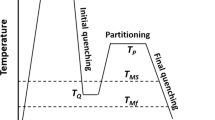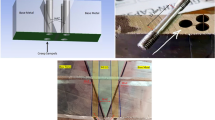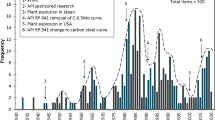A method is proposed for the isothermal quenching of rails to lower bainite with the use of cold water as the quenching medium. The cooling capacity of the water is reduced by the pulsed feed of individual portions of water to the surface of the rail head in a regime which keeps the temperature of the rail surface within the temperature range of the bainite transformation. The replacement of conventional steel with a pearlitic structure by bainitic steel improves the wear resistance of rails. The new quenching technology makes use of an environmentally clean quenching medium and forms a favorable residual-stress diagram that improves the durability of rails.






Similar content being viewed by others
References
K.-D. Boer, S. Datta, and G.-Y. Kaiser, “High-strength rails with a bainitic structure obtained from rolling heat,” Chernye Metally, No. 2, 29–36 (1995).
A. F. Zolotarskii, Ya. R. Rauzin, E. A. Shur, et al., Rails Strengthened by Heat Treatment [in Russian], Transport, Moscow (1976).
L. M. Pevzner, “Use of isothermal treatment to increase the structural strength of steel,” Zh. Tekh. Fiz., 19, No. 4, 481–491 (1949).
L. M. Pevzner, “Structure and properties of steel quenched in hot media,” Physical Metallurgy and Heat Treatment: Symposium, Mashgiz, Moscow (1955), pp. 74–107.
Ya. M. Potak, High-Strength Steels [in Russian], Metallurgiya, Moscow (1972).
M. V. Pridantsev, D. S. Kazarnovskii, V. I. Danilov, et al., “Isothermal treatment of rails,” Stal, No. 4, 358–361 (1965).
D. S. Kazarnovskii, M. V. Pridantsev, A. P. Babich, et al., “Properties of isothermally quenched rails made of carbon steels and alloy steels,” Stal, No. 5, 465–468 (1970).
N. I. Kobasko, B. I. Nikolin, A. G. Arachinskaya, et al., “Increasing the service life of machine and instrument parts by creating high compressive stresses in them,” Izv. Vyssh. Uchebn. Zaved. Ser. Mashinostr., No. 10, 153–157 (1987).
N. V. Zimin and I. K. Akimov, “Pulsed cooling – a method of controlling the cooling ability of water,” MIToM, No. 6, 28–31 (1964).
F. Moro and P. Arshambolt, “Polymeric quenching media and computerized control of sprayer quenching,” Prom. Teplotekhn., 11, No. 3, 48–55 (1989).
Yu. A. Samoilovich, “Analysis of the thermal stress state of rails during bulk quenching,” Metallurg, No. 11, 65–72 (2011).
Yu. A. Samoilovich, “Possibilities for producing high-strength rails with minimal warpage,” Metallurg, No. 12, 57–64 (2011).
D. Ya. Vishnyakov, “Properties of molten salts used in furnace baths,” Structure and Properties of Steel: Tr. Mosk. Inst. Stali (1949), Iss. 27, pp. 126–175.
M. Umemoto, K. Horiuchi, and I. Tamura, “Transformation kinetics of bainite during isothermal holding and continuous cooling,” Trans. ISIJ, 22, 854–861 (1982).
Author information
Authors and Affiliations
Corresponding author
Additional information
Translated from Metallurg, No. 10, pp. 70–76, October, 2012.
Rights and permissions
About this article
Cite this article
Samoilovich, Y.A. Strengthening railroad rails by isothermal quenching to lower bainite. Metallurgist 56, 779–786 (2013). https://doi.org/10.1007/s11015-013-9650-z
Received:
Published:
Issue Date:
DOI: https://doi.org/10.1007/s11015-013-9650-z




